
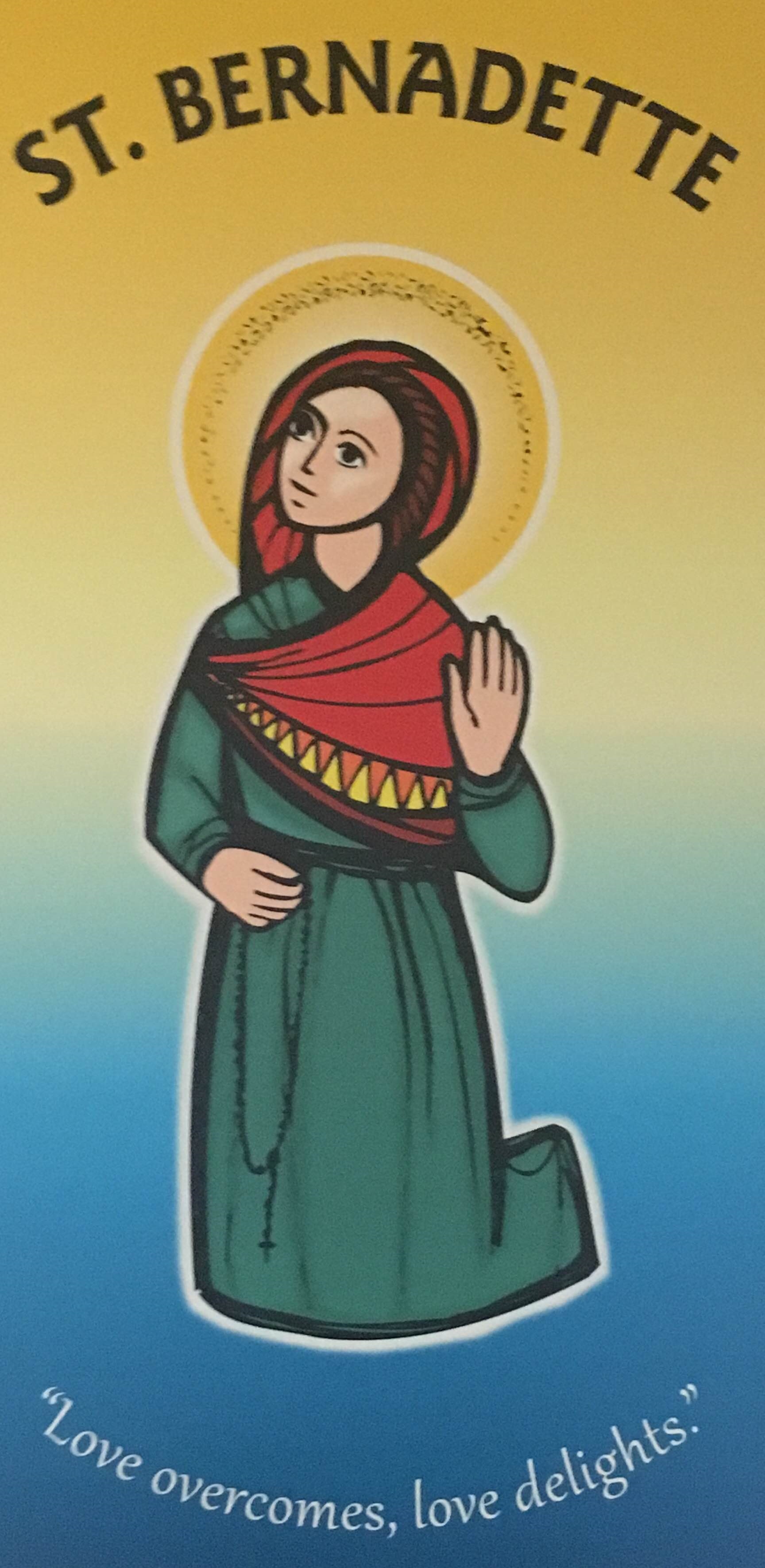
Bernadette Soubirous was born in Lourdes, France to Francois and Louise Casterot who were very poor. She was the oldest of six children but was frail and often sick. On Thursday, February 11, 1859, around the time of her First Communion, Bernadette was sent with her younger sister and a friend to gather firewood. And this is the story she had to tell, which was taken from a letter she wrote:
"I had gone down one day with two other girls to the bank of the river Gave when suddenly I heard a kind of rustling sound. I turned my head toward the field by the side of the river, but the trees seemed quite still and the noise was evidently not from them. Then I looked up and caught sight of the cave where I saw a lady wearing a lovely white dress with a bright belt. On top of each of her feet was a pale yellow rose, the same colour as her rosary beads. At this I rubbed my eyes, thinking I was seeing things, and I put my hands into the fold of my dress where my rosary was. I wanted to make the sign of the cross, but for the life of me I couldn't manage it, and my hand just fell down. Then the lady made the sign of the cross herself, and at the second attempt I managed to do the same, though my hands were trembling. Then I began to say the rosary while the lady let her beads clip through her fingers, without moving her lips. When I stopped saying the Hail Mary, she immediately vanished."
The beautiful lady who appeared to Bernadette above a rosebush in the grotto of Massabielle was God's Mother, the Blessed Virgin Mary. She appeared to Bernadette eighteen times and spoke with her. She told Bernadette that she should pray for sinners and do penance. The Lady also told her to have a chapel built there in her honor. Many people did not believe Bernadette when she spoke of her vision. She had to suffer very much. But one day Our Lady told Bernadette to dig in the mud. As she did, a spring of water began to flow. The next day it continued to grow larger and larger. Many miracles happened when people began to use this water. When Bernadette was older, she became a sister. She was always very humble and did not want to be praised. She did not want to receive special treatment just because she had actually seen the Blessed Virgin. Although her own health was poor, she helped care for the sick and elderly sisters. She died in 1879 at the age of thirty-six. Her last words were: "Holy Mary, pray for me, a poor sinner."
THINKING SKILLS
We continue to use De Bono’s Thinking Hats, Habits of Mind and a variety of Thinking Maps to develop the children’s thinking skills. Regular reference is made during lessons to Edward De Bono’s Thinking Hats, Habits of Mind and Thinking Maps. Ask your child to tell you about which one/s they have used in class today!

We have discussed the rules that we feel will help the children to learn and work in a happy and positive environment. The children have also discussed the importance of having rules and how they can keep us all safe. Additionally, the rules reflect the ethos and mission statement of St. Mary’s school. These are displayed in our classroom. The school’s rewards and sanctions for good and bad behaviour have also been discussed with the children and displayed in the classroom.

Spellings, X Tables, Literacy, Numeracy, Mental Maths and Handwriting homework will be given every Wednesday to be handed in on Monday of the next week. Your child can hand in their homework earlier if they wish. The purpose of the homework is to reinforce learning that has taken place in class. It is also an opportunity for you to see what your child is learning. Each week the work will be explained and we will discuss any questions that they may have. The weekly spelling test will take place during the week to allow your child to practise the spelling pattern that they have focused on in lessons. Please ensure your child has practised and learnt their spellings during the week. Other homework may also be given relating to either RE, Science or history if required.
Now that the children are moving into KS2, a greater emphasis will be placed on being more independent and responsible. Your child’s homework is therefore an opportunity for them to take responsibility themselves; ensuring homework is always completed and handed in on time.
READING
At present your child will still be bringing home a school reading book. Please ensure that your child reads every night in order to develop fluency. Reading records are provided for date, book and comments to be added by an adult. Please ensure that the reading records are signed each time your child is listened to read. Also, if you could spend a little time talking about the text and asking questions to encourage your child to really think about what they have read. This will greatly help their comprehension skills. Evidence shows that good readers are also good spellers and good writers. Reading records will be checked by the class teachers every Monday and we will expect to see five adult signatures showing that you have heard your child read.
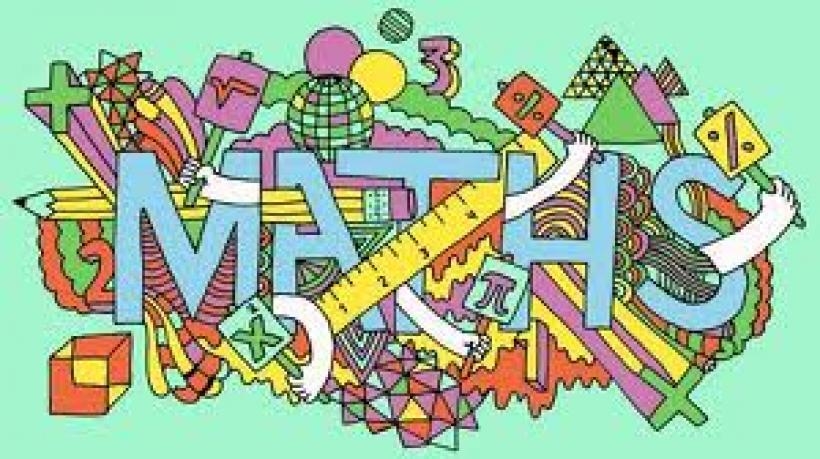
Topics to be covered this term:
-
Multiplication and Division
-
Length and Perimeter
-
Fractions
-
Mass and Capacity
In addition: daily multiplication tables practice and weekly mental maths test
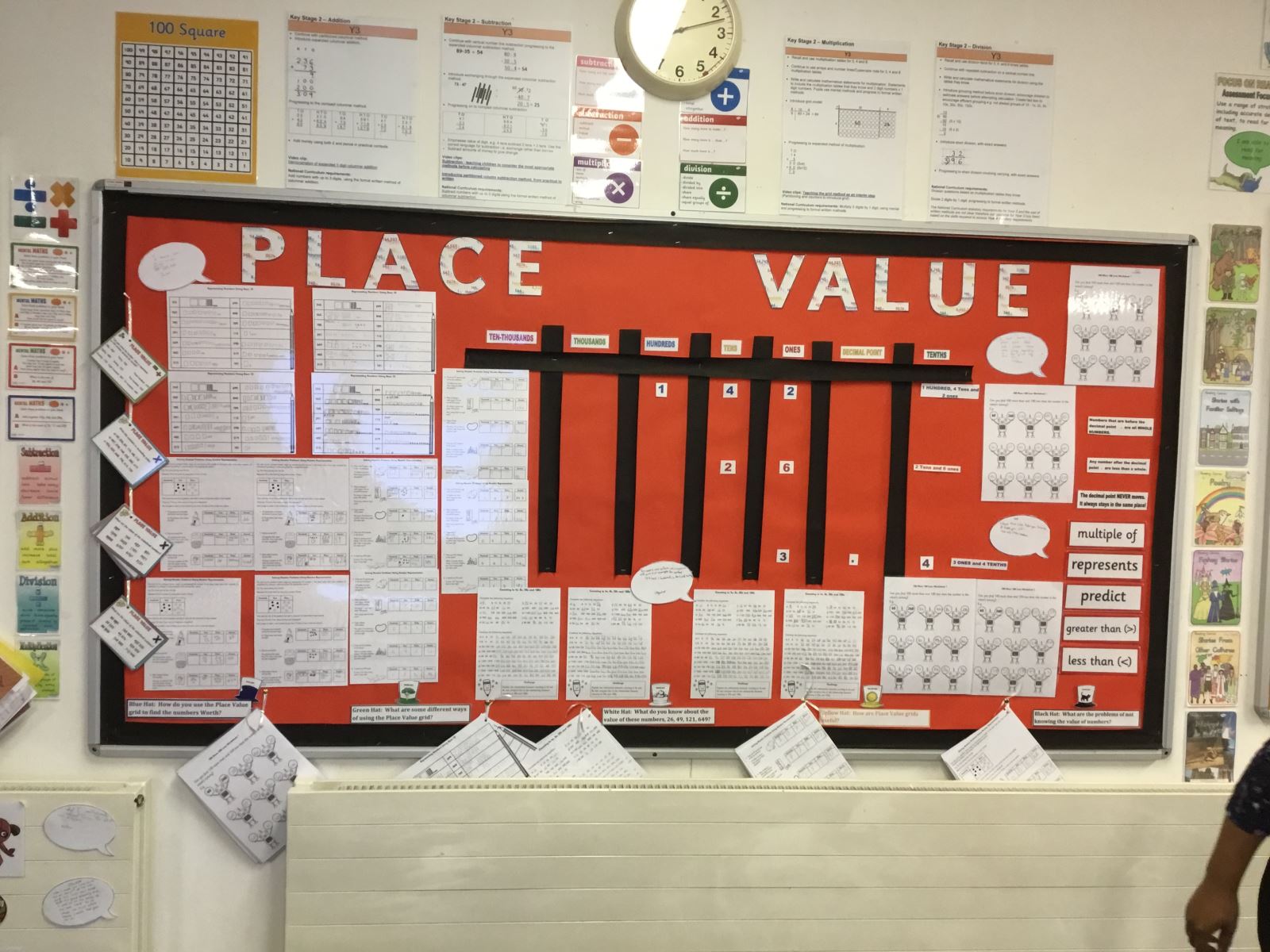
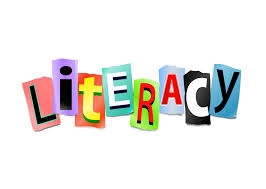
Following the New Curriculum
Fiction
Myths and Legends
Adventure Stories
Non-fiction
Information text; report writing (linked with History).
Poetry
In addition: weekly spellings and test, guided reading, creative writing, grammar work and handwriting practice three times each week.
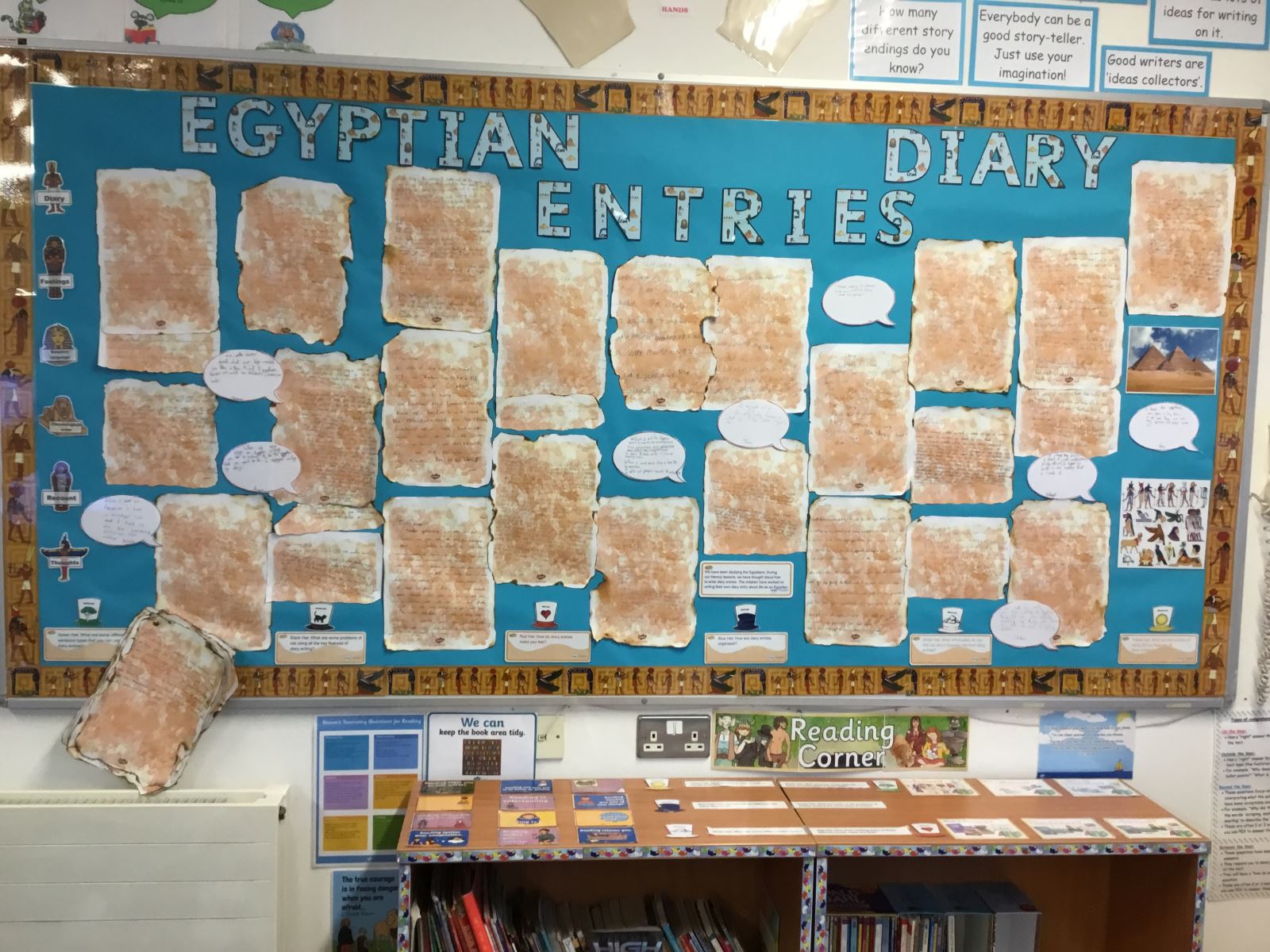

Animals including Humans:
In this unit, children will learn to:
-
To identify the important things that need to be considered in order to survive.
-
To classify food and understand a balanced diet
-
To identify the similarities and differences between skeletons and explore their functions
-
To apply knowledge of skeletons to design a skeleton of an animal.
-
To identify different muscles in our body and what they do
-
To plan a pattern-seeking investigation related to the human body
-
To draw conclusions based on data gathered in an investigation
-
To use different sources of information to plan a menu to meet particular dietary needs
Working Scientifically:
-
To explore
-
To group and classify
-
To use secondary sources of information
-
Look for patterns in data
Rocks:
-
To examine different rocks in order to describe, compare and contrast their properties
-
To sort rocks according to their properties using a key
-
To investigate how rocks change over time
-
To explain that soils are made partly from rock that has broken down into smaller particles and describe some of the properties of different types of soils
-
To investigate and test different kinds of soils to see how quickly water drains through
-
To explore fossils to find out what they are
-
To explain how fossils came to be formed
-
To identify where and how fossils are found
Working Scientifically:
-
To group and classify
-
To ask relevant questions and using different types of scientific enquiries to answer them
-
To observe changes over time
-
To carry out comparative and fair tests
-
To use secondary sources of information
-
Finding things out using secondary sources of information

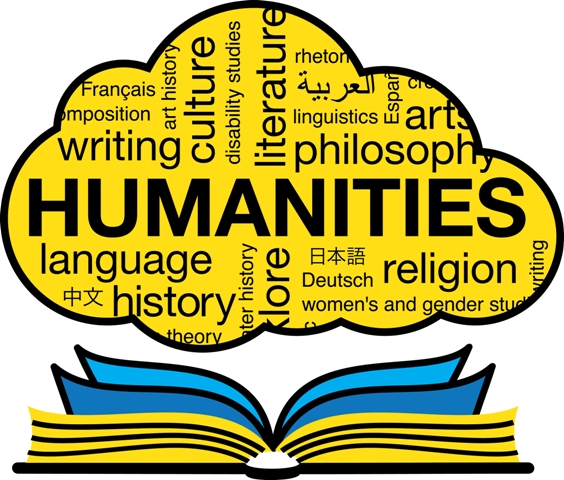
Geography:
Earthquakes and Volcanoes:
In this topic children will learn about plate tectonics and look at the new terminology surrounding this unit. They will discover how an earthquake and volcano is formed and how these natural events can have an impact on human life.
Landscapes-Rivers and Mountains:
In this topic, the children will be understanding the physical processing of weathering and how it affects landforms. They will learn about the physical features of a river and locate key mountain ranges of the world using an atlas.
(Link with Literacy, ICT, Art and D&T)
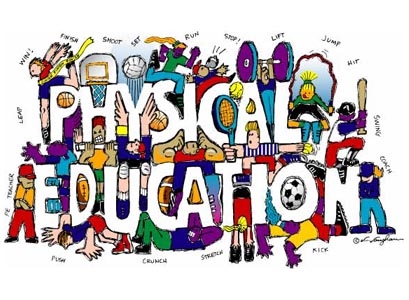
The units of work being covered in the Spring term are: hockey, tennis, dance genres and gymnastics with apparatus.
The children will be taught different ways to warm up and cool down and learn the rules for hockey and tennis and play matches using the equipment accurately. For dance and gymnastics, the children will be using the equipment to help them accurately move effectively either as a sole piece or as a group.
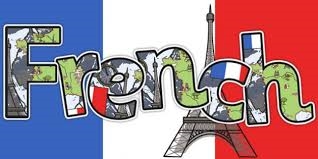
The children will be extending their vocabulary this term, enabling them to talk particularly about: members of the family, parts of the body; the weather; vocabulary connected with school work and the curriculum.
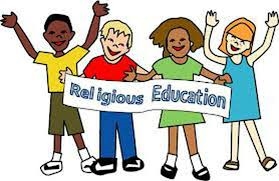
Galilee to Jerusalem:
In this branch, pupils will encounter the Gospel of St. Matthew. Matthew’s gospel is divided into 7 books. The first contains the birth and infancy narratives, the last describes Jesus’ passion, death and resurrection, and the five books in between give an account of the life and ministry of Jesus. The scriptural texts studied in this branch draw from two sections, a narrative section on 10 miracles and a sermon on parables. Parables are one of Jesus’ teaching methods. In using them, he prompts listens to think differently.
Desert to Garden:
Following on from focusing on the Liturgy of the Word in the ‘Prophecy and Promise’ branch, pupils will focus on the second part of the Mass, the Liturgy of the Eucharist. With Jesus Christ, our risen Lord, we are celebrating the big feast of thanksgiving. The Eucharist is the meeting point with the Kingdom of God. Jesus emptied himself into humanity and through the Eucharist invites It gives a thorough explanation of what happens at Holy Mass and the real presence of Jesus Christ in the Eucharist.

This term the children will be learning about how to:
Online Safety:
The children will be learning to:
-
Differentiate between fact, opinion and belief online.
-
Explain how to deal with upsetting online content.
-
Recognise that digital devices communicate with each other to share personal information.
-
Explain what social media platforms are used for.
-
Recognise why social media platforms are age-restricted.
Creating Media:
The children will be learning to:
-
Describe the purpose of a trailer.
-
Create a storyboard for a book trailer.
-
Consider camera angles when taking photos or videos.
-
Import videos and photos into film editing software.
-
Record sounds and add these to a video.
-
Add text to a video.
-
Incorporate transitions between images.
-
Evaluate their own and others’ trailers.
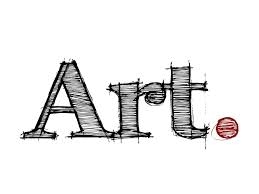
Earthquakes and Volcanoes:
In this unit, the children will explore the artwork from different artists who were inspired by the effects of earthquakes and volcanoes. They will use different media such as: paint, water colours and clay to create pieces of art inspired by volcanoes. This unit links to the Geography unit of Earthquakes and Volcanoes so the children will have a good background understanding of the artist’s inspiration.
Myths and Legends:
In this unit, the children will be understanding how myths and legends have inspired the work of artists. They will be finding out what inspired Peer Paul Rubens as an artist and try to imitate his techniques.

Electronic Charms
We will be understanding the impact of the digital revolution in the world of (D&T) product design. We will write a program to initiate a flashing LED panel after button press and/or automatically initiate using the Micro: bit light sensing, as part of an eCharm. The children will then create and decorate a foam pouch for the eCharm, using a template. Finally they will design a display badge and/or stand using CAD (computer-aided design) software for an eCharm product.
Eating Seasonally
The children will learn that climate affects food growth. We will learn the advantages of eating seasonal foods grown in the UK. The children then create a recipe that is healthy and nutritious using seasonal vegetables and fruits. Finally, the children learn how to safely follow a recipe.

PSHE/ CITIZENSHIP & RSE EDUCATION:
Information from the Ten Ten Resources:
Religious Understanding
This unit tells the parable of The Prodigal Son, showing that God loves us, and nothing we can do will stop Him from loving us. Children will also learn about different types of sin, and the importance of forgiveness in relationships.
Personal Relationships
This unit helps the children to develop a more complex appreciation of different family structures, develop healthy relationships with family and friends and learn some strategies to use when relationships become difficult. Teaching also covers how to recognise discrimination and bullying, both physical and emotional. Children will learn strategies to develop resilience and resist pressure.
Keeping Safe
This unit incorporates some of the excellent NSPCC Share Aware resources, as well as teaching on bullying and physical, emotional and sexual abuse through a series of animated stories. Through the animated expert Dr Datfa, children will also learn in greater depth about the effects of drugs, alcohol and tobacco and how to make good choices concerning these as they get older. The final session of the Module explores in more detail what to do in emergency situations.

MUSIC:
This term the children will be learning to use percussion instruments to create a rhythmic pattern. They will be building up their skills each week so that they will eventually be able to create a collaborative piece using the percussion instruments.
This term, the children will be taking part in weekly recorder lessons where they will be learning how to read music as well as how to play specific notes.
We look forward to working in partnership with you and your child this year. Please do not hesitate to contact us if you wish to discuss anything.
Thank you in advance for your support,
Mrs Falzone